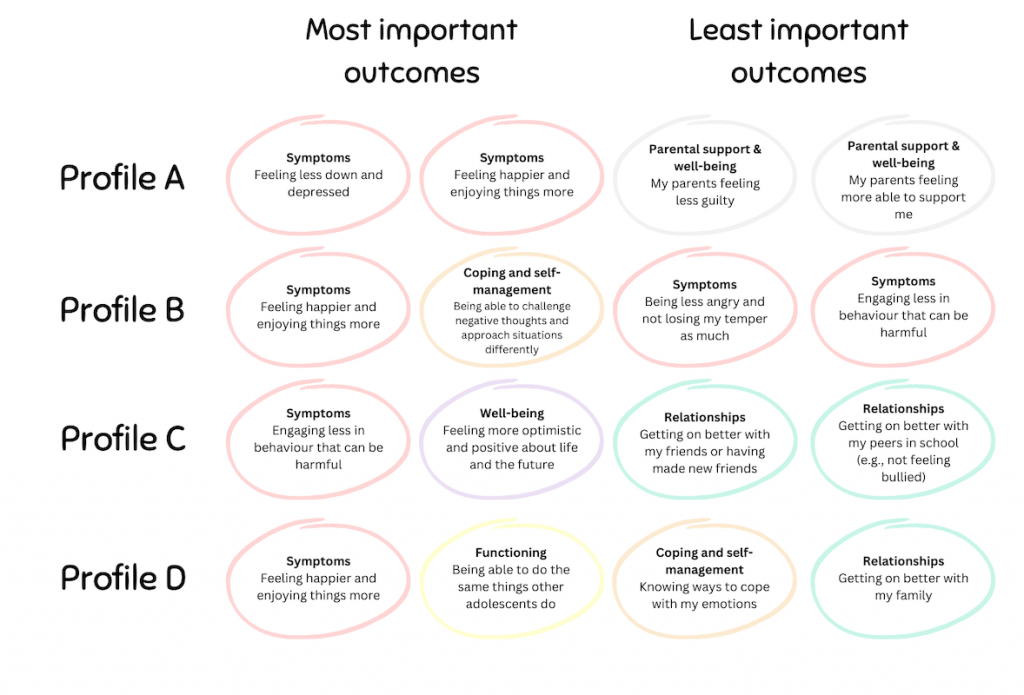
When assessing the effectiveness of a treatment for depression, the identification of appropriate outcome measures is vital. Think about it this way: if research demonstrates that a treatment leads to significant improvements in a chosen outcome for a given population, we tend to say that the treatment is effective, and will start recommending it for this population. But what if the outcomes we are choosing are not the right ones? What if other outcomes – ones that we haven’t considered and haven’t measured – are the most important? If this is the case, then the way we are judging and recommending treatments is wrong!
Along with other mood disorders, depression most commonly emerges during adolescence, with a peak age of onset towards age 20 (Solmi et al., 2022). In recent decades, depression and other common mental health concerns have been increasing in prevalence, with COVID-19 leading to significant increases worldwide in children and adolescents (Kauhanen et al., 2022). As depression in this age group is a major risk factor for suicide attempts in adolescence, continuity of depression into adulthood, and is associated with other co-morbid and later life mental health conditions (Rao & Chen, 2009), there is an urgent need to have age-appropriate, effective, evidence-based treatments for depression in children and young people.
As highlighted in a 2019 Mental Elf blog by Tamsin Ford of an earlier paper by Krause and colleagues (2019) most research on treatments for adolescent depression focus on clinician report and symptom-based outcomes. Therefore, current recommended treatments (e.g., those recommended by the National Institute for Health and Care Excellence) are based on symptom outcomes. This has translated into clinical practice, where patients are asked to complete standard symptom questionnaires before and after receiving treatment.
However, research has not investigated whether these outcomes are meaningful for adolescents, leaving a gap in our knowledge as to whether these are the standards by which we should be assessing and recommending treatments for this population. This led Klause and colleagues (2021a) to ask the following question: “What treatment outcomes matter most to adolescents with depression?”.

Are the current outcomes we use to judge and recommend treatments for depression meaningful to adolescents? And what are the consequences if they’re not?
Methods
The researchers used convenience sampling to recruit 28 young people (16-21 year olds) with lived experience of receiving treatment for depression.
Participants were asked to complete a Q-sort, which involved ranking a set of cards with written statements of treatment outcomes (e.g., “Knowing ways to cope with my emotions” and “Feeling more confident”) based on 8 outcome domains:
- Symptoms
- Coping and self-management
- Functioning
- Personal growth
- Relationships
- Therapeutic space
- Well-being
- Parental support and well-being
They ranked 35 statements on a 9-point scale from -4 (least important) to +4 (most important). These statements and domains were informed by previous studies (Krause et al., 2019; Krause et al., 2021b).
Inverted ‘by-person’ principal component analysis was conducted to identify common outcome priority profiles across adolescents. The best solution was the one that maximised variance explained (best explained the commonalities across participants) and where the most participants answers loaded onto (closely resembled) only one profile. Scores for each of the Q-sorts were calculated for each of these profiles to create archetypal profiles.
Following the Q-sort, participants took part in brief interviews where they were asked about their reasoning behind their sorting. This was analysed through content analysis, to help the researchers interpret the identified archetypical profiles.
Results
Four outcome priority profiles were identified that, combined, explained 48.7% of the total variance:
- Profile A (Relieving depression and experiencing a happier emotional state) most prioritised emotional and peer relationship outcomes, and least prioritised parental support and well-being.
- Profile B (Learning to cope with cyclical distressing emotional states) prioritised learning skills such as better understanding and talking about emotions and least prioritised improvements in anger and risky behaviour. These adolescents tended to describe their depression as cyclical.
- Profile C (Understanding and processing distressing emotional states) prioritised reducing self-harm, feeling more optimistic, having a therapeutic space, and feeling more understood by parents. It de-prioritised improving peer relationships and functioning outcomes. These adolescents had high prevalence of challenges related to neurodiversity.
- Profile D (Reduced interference of ongoing distressing emotional states with daily life) prioritised being able to do things that other adolescents do and reduced parental guilt, whereas it de-prioritised coping outcomes and getting on with family. These adolescents appeared to represent a more severe subset, with 2/3 adolescents having been admitted to inpatient care.
Profiles A, B, and C had similar proportions of variance explained, with D showing less, suggesting that D may be a less common profile.
Across all profiles, the symptom outcomes of ‘feeling happier and enjoying things more’, and ‘feeling less down and depressed’ scored as very important, whereas ‘getting on better with my peers in school (e.g., not feeling bullied)’ and ‘attending school more regularly’ were scored as not important across profiles (see Figure 1 ).
Interestingly, three participants did not have answers that loaded well onto any of the profiles. Two were non-significant, and one had significant cross-loadings, meaning that their answer was a mix of two different profiles. These were individuals from minority ethnic backgrounds, which could suggest that the four identified profiles do not represent ethnic minority perspectives.
Figure 1. Adapted from Figure 2 in Krause et al. (2021), made on Canva. View full-sized figure.

By applying the novel Q-sort methodology, the authors identified four outcome priority profiles which explained almost half (48.7%) of the total variance.
Conclusion
The authors found that symptom outcomes were generally prioritised across profiles, suggesting that it is appropriate to continue assessing symptom improvement in adolescent depression, both in research and clinical practice.
Comparing profiles, some highly prioritised outcomes were highly de-prioritised in others, suggesting that heterogeneity is the rule. It therefore may not be appropriate to make generalisations regarding adolescents’ priorities, but rather consider specific subgroups or individuals. The authors highlighted that the profiles:
differed with regards to the importance assigned to coping skills, the processing of past experiences and emotions, and functional impairment. These differences in outcome priorities appeared to be associated with varying degrees and types of complexity in youth’s mental health histories, as well as young people’s cognitive representations of depression and the perceived room of opportunity for improvement.
The profiles identified by this research are likely to provide a good starting point for future investigations regarding meaningful treatment outcomes, which in turn may lead to better quality and more effective care due to tailored treatment.

Outcome priorities showed both consistency and heterogeneity across the four profiles, highlighting that while symptom improvement is an appropriate target, individual priorities must also be considered.
Strengths and limitations
This research used mixed methods; combining quantitative and qualitative techniques. This triangulation allowed the authors to interpret why adolescents may prioritise certain outcomes, distinguishing between not struggling with a certain difficulty versus not valuing improvement in that area. Utilising the Q-sort methodology was also a particularly novel and creative approach, having not been applied to this type of research question before.
This study is a good example of participant involvement. The Q-sort was developed through workshops with a range of informants, reducing the influence of researcher bias. Further, during the study, participants were asked whether the Q-sort represented all important outcomes, or if anything had been missed. This also identified a limitation of the study: ‘overcoming boredom/numbness’ and ‘finding hobbies’ were both identified as outcomes missing from the set. If these additional cards were added, it is possible that different profiles would have emerged. However, this knowledge enables future research to further refine a Q-sort set for this population.
On the other hand, this study did not use certain practices that are being increasingly recognised as gold standard. For example:
- Minimal information was available on how the content analysis was conducted and rated. From this, it could be assumed that interviews were only single-rated, which could have added significant bias to how the meanings of the profiles were interpreted.
- Statistical analyses were not pre-registered, which reduces researcher integrity and accountability, and can undermine the confidence we can have in the validity of the profiles identified.
Finally, and as identified by the researchers, their recruitment method was unable to recruit younger adolescents, and was likely to exclude more severe (e.g., current inpatients) and non-treatment seeking individuals, who may have prioritised different outcomes. Overall, prior to replication, it is unknown whether these identified profiles would also be found in other samples of adolescents.

While this study demonstrated strengths in participant involvement and novelty, participants identified important missing outcomes, and the recruitment method excluded participants who may have prioritised different outcomes.
Implications
Despite limitations, the findings from this study have important clinical and research implications for treating adolescent depression.
For clinicians, it may be beneficial at the beginning of a case of treatment for adolescent depression to develop a set of personalised outcome goals with the patient, with recognition that this is likely to vary greatly between individuals. Treatment could then be jointly chosen by the patient and clinician to ensure these priorities are addressed. This approach could also take into account what the patient thinks their key problem areas are, and what they consider to be valuable improvements. This would also provide a good framework when reviewing clinical decisions of whether to continue or change treatments.
Personally, I have found that goal setting has been useful in my experience of mental health treatment. Recovery goal setting is already part of certain treatment programmes such as Maudsley Model of Anorexia Nervosa for Adults (MANTRA) and can be a part of cognitive behavioural therapy (CBT). Goal setting is also, in my opinion, a useful skill for young people to learn to apply in life more generally.
This is also relevant for child and adolescent mental health services when evaluating treatment efficacy in service reviews. Additional outcomes could be included pre- and post-treatment to reflect a broader range of priorities. However, more research with a broader, diverse range of adolescents is still needed to determine which additional outcomes are most appropriate. This is similarly needed in research when developing new treatments for this population, rather than only relying on symptom outcomes to judge treatment efficacy.

Looking to the future, research like this could transform how we approach treating adolescent depression, with a focus on monitoring a broader range of outcomes and personalising treatment plans to the individual.
Statement of interests
Danielle Brocklebank does not have any affiliation with the authors of this study, is not currently working on similar research, and has no conflicting financial interests.
References
Primary paper
Krause, K. R., Edbrooke-Childs, J., Bear, H. A., Calderón, A., & Wolpert, M. (2021a). What treatment outcomes matter most? A Q-study of outcome priority profiles among youth with lived experience of depression. European Child and Adolescent Psychiatry, 32(1), 123–137.
Other references
Ford, T. (2019). Depression in young people: are we researching what matters most? The Mental Elf.
Kauhanen, L., Wan Mohd Yunus, W. M. A., Lempinen, L., Peltonen, K., Gyllenberg, D., Mishina, K., Gilbert, S., Bastola, K., Brown, J. S. L., & Sourander, A. (2022). A systematic review of the mental health changes of children and young people before and during the COVID-19 pandemic. European Child and Adolescent Psychiatry, 0123456789.
Krause, K., Midgley, N., Edbrooke-Childs, J., & Wolpert, M. (2021b). A comprehensive mapping of outcomes following psychotherapy for adolescent depression: The perspectives of young people, their parents and therapists. European Child and Adolescent Psychiatry, 30(11), 1779–1791.
Krause, K. R., Bear, H. A., Edbrooke-Childs, J., & Wolpert, M. (2019). Review: What Outcomes Count? A Review of Outcomes Measured for Adolescent Depression Between 2007 and 2017. Journal of the American Academy of Child and Adolescent Psychiatry, 58(1), 61–71.
Rao, U., & Chen, L. A. (2009). Characteristics, correlates, and outcomes of childhood and adolescent depressive disorders. Dialogues in Clinical Neuroscience, 11(1), 45–62.
Solmi, M., Radua, J., Olivola, M., Croce, E., Soardo, L., Salazar de Pablo, G., Il Shin, J., Kirkbride, J. B., Jones, P., Kim, J. H., Kim, J. Y., Carvalho, A. F., Seeman, M. V., Correll, C. U., & Fusar-Poli, P. (2022). Age at onset of mental disorders worldwide: large-scale meta-analysis of 192 epidemiological studies. Molecular Psychiatry, 27(1), 281–295.
Photo credits
- Photo by Antonino Visalli on Unsplash
- Photo by Makoto Tsuka on Unsplash
- Photo by Tanbir Mahmud on Unsplash
- Photo by Kinga Howard on Unsplash
- Photo by Priscilla Du Preez on Unsplash
